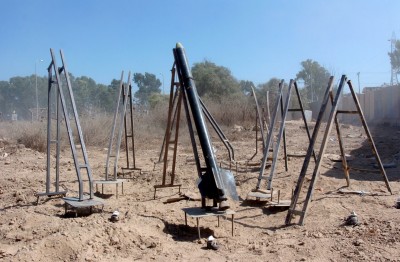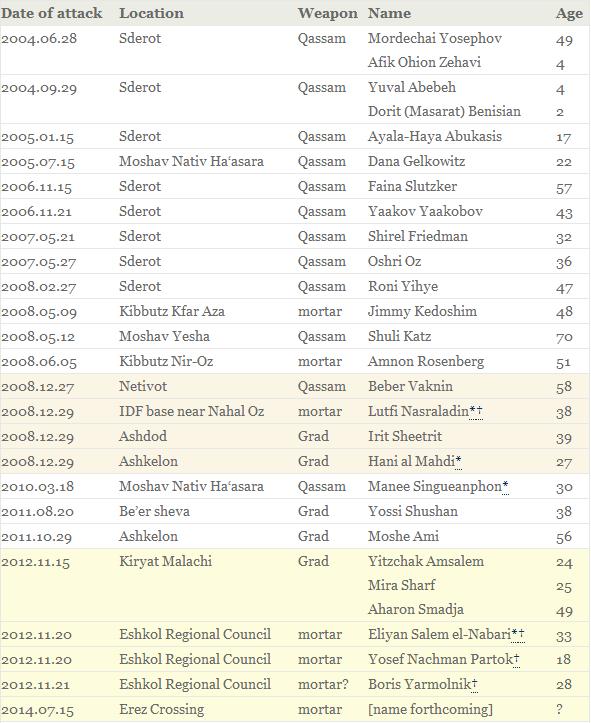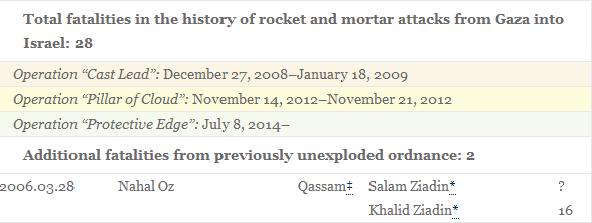How Many People have Died from Gaza Rockets into Israel?

Fatalities from rocket and mortar attacks in Israel from the Gaza Strip, 2001–present (up-to-date as of July 15, 2014)
This page provides a current listing of total fatalities resulting from Gaza rockets and mortar shells into Israel and will be updated when necessary.
Total Israel fatalities over a ten year period of 28 compared to more than 200 Palestinian deaths in the last 2-3 week. (M. Ch. GR Editor)
Refer to the bottom of the page for notes and sources.)
Throughout news coverage of Israeli strikes into Gaza and rocket into Israel, certain numbers and infographics are bandied about frequently:
- total fatalities for the duration of an Israeli military operation
- number of Gaza rockets and mortar rounds fired into Israel
- type of Gaza rockets and mortar shells fired into Israel—often with size dimensions, payload, and range
- a display of the potential reach of Gaza projectiles superimposed on a map of Israel
- number of projectiles supposedly intercepted by Iron Dome
- explanations of how Iron Dome works
However, there is little attempt to describe other equally relevant data:
- amount of ordnance fired by Israel into Gaza
- types of weapons utilized by Israel, along with their firepower and range
- a display of the potential reach of Israeli armaments superimposed on a map of the Gaza Strip
And perhaps most surprisingly,
- the total number of people of who have been killed by Gaza rockets and mortars into Israel
The last count is especially important because of the rhetoric that relies on the threat level from Gaza rockets and mortars.
Additionally, discussion of the efficacy of Iron Dome has been almost exclusively relegated to the number of projectiles intercepted but not to the number of lives saved, which is presumably the ultimate goal. When a correlation is made between Iron Dome’s efficacy and the number of lives saved, it is often expressed in vague or implausible terms, such as “countless lives saved”, “hundreds of lives saved,” and even “thousands of lives saved.” However, Iron Dome was rolled out in stages beginning March 27, 2011. In the ten years prior to Iron Dome, only 17 fatalities were incurred.
Outside of this site, there is no easily accessible listing of fatalities resulting from Gaza rockets and mortars into Israel. A previous listing prepared by me was written before the conclusion of Israel’s November 2012 offensive and is now out of date.
Therefore I strive to maintain an up-to-date listing on this page for the benefit of journalists and analysts.
Faulty numbers on the internet
As I noted in my previous rocket fatality count, numbers distributed by Israeli agencies are wildly inaccurate and often contradictory. This is propounded by sources such as Wikipedia, which at the time of this writing repeats the discredited and unaccounted numbers provided by Israeli agencies.
As I also reported, injuries resulting from rocket and mortar strikes are exaggerated. Israel’s casualty counts always incorporate numbers of people who have been treated for “shock and anxiety,” as well as “light injuries” resulting from the rush to safety, such as “falling down the stairs.”
This practice is not employed in Gaza, nor for any other conflict.
Journalists are urged to take these factors into account when reporting on numbers.
Changes from the previous table
In addition to adding the three fatalities that occurred after publication of my earlier listing, I have reformatted the table to indicate the number of fatalities resulting from each strike.
In order to prevent confusion, I have also separated the two fatalities that resulted from handling unexploded ordnance.
Sources include, but are not limited to, the Israeli Ministry of Foreign Affairs, the Israeli Prime Minister’s Office, the Israel Project, the Jerusaelm Post, B’Tselem, and numerous press articles. I made a point of referring to official Israeli and pro-Israeli sources (which were less likely to undercount), and then cross-checking them with one another. Some ages and spellings of names vary among reports. The dates refer to when the victim was struck, not necessarily when the victim succumbed to injuries.
* Six of the fatalities were non-Jewish: Salam Ziadin, Khalid Ziadin, Hani al Mahdi, and Eliyan Salem el Nabari were Bedouin; Lutfi Nasraladin was Druze; Manee Singueanphon was a Thai national.
† Three of the fatalities were military personnel, while a fourth was a civilian killed at a military installation. Sgt.-Major Lutfi Nasraladin was killed in a mortar attack on an IDF base near Nahal Oz. Cpl. Yosef Partok, Lt. Boris Yarmolnik, and Eliyan el-Nabari were each killed in separate incidents in military posts in the Eshkol Regional Council. El-Nabari had been contracted by the Israeli Defense Ministry to build tents for soldiers who were awaiting ground deployment.
‡ Salam and Khalid Ziadin were killed while handling an unexploded Qassam rocket for salvaging. The Israeli Ministry of Foreign Affairs does not include the Ziadins in its list of “Victims of Palestinian Violence and Terrorism.”
This list does not include:
1. Palestinians killed by rocket or mortar misfire in the Gaza Strip.
2. People killed by Gaza rockets and mortars targeted inside the Gaza Strip. Prior to the Gaza “disengagement,” illegal Israeli settlements within the Gaza Strip were targeted by rockets and mortars. They were not aimed inside Israel. They also do not form part of the rhetoric that rockets and mortars from Gaza constitute an “existential threat” to Israel.
In Gaza settlements and the Erez Industrial Zone, rocket and mortar attacks inflicted eight civilian fatalities: three Israeli Jews, three foreign laborers from Thailand and China, and two Palestinian laborers from Khan Younis.
Additionally there were two IDF fatalities in Gaza settlements, including a soldier killed while on his way to guard duty in Kfar Darom and a soldier killed at an IDF outpost in the Morag settlement.
All other rocket and mortar fatalities within Gaza were directed against IDF soldiers engaged in military operations outside of settlements.
3. One fatality in Israel by anti-tank missile. The rockets-and-mortars rhetoric refers to high-trajectory ordnances deployed with the following qualities: indirect fire, which coupled with a high inaccuracy rate results in nondiscriminatory targeting; a wide range that encompasses significant portions of southern Israel; and a high deployment frequency.
Anti-tank missiles are direct-fire ordnances with a more limited range and have been used infrequently against civilian targets by Gazan armed groups. There has been one civilian fatality from an anti-tank missile fired from the Gaza Strip into Israel (Daniel Viflic, age 16, killed on April 7, 2011, near Kibbutz Sa‘ad, by an anti-tank missile that struck the bus he was riding in). B’Tselem does not include this instance in its count of rocket and mortar fatalities.



